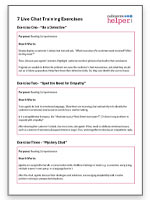What do customers want from live chats?
They may need information, help in solving a problem, or just want to vent. They also want to feel supported and treated as individuals. To satisfy those needs, chat agents require specific reading, writing, empathy, and problem-solving ability.
In this article, Mike Aoki, President of Reflective Keynotes Inc., shares seven exercises to help develop these skills – during new hire training, team meetings, huddles, or coaching sessions.
1. “Be a Detective” – Reading Comprehension Exercise

The first step is identifying what a customer needs. That sounds easy. However, I have seen too many chats where the agent did not understand the initial enquiry.
Help your agents develop reading comprehension and diagnostic skills with the “Be a Detective” exercise.
How does it work? Simply display a customer’s initial chat text and ask, “What issue does the customer want resolved? What do they need?”
Then, discuss your agents’ answers. Highlight customer words or phrases that lead to that conclusion.
If agents are unable to define the problem because the customer’s text was unclear, ask what they would ask as a follow-up question. Help them hone their detective skills so they can identify the correct issue.
For advice on the steps you need to take to better understand every customer, read our article: 3 Steps to Better Understanding Your Customers
2. “Spot the Need for Empathy” – Reading Comprehension Exercise
While being a “detective” helps agents identify the correct issue to solve, some customers also seek empathy and appreciation.
For these customers, fixing the problem is not enough. You also need to fix the relationship between the customer and your company.
So, train agents to look for emotional language. Show them an incoming chat and ask them to identify the customer’s emotional tone based on word choice and formatting.
Is it a straightforward enquiry, like “How late is your Main Street store open?” Or does it require the agent to respond with empathy?
After showing the customer’s initial chat on screen, ask agents if they need to address emotional issues, such as customer frustration, disappointment or anger. If so, work together to develop an empathetic reply.
If you are looking for what agents can say to show empathy, read our article: Empathy Statements for Customer Service With Examples
3. “Mystery Chat” – Reading Comprehension Exercise
Use what Melissa Hurley, Vice President, Learning and People Development at Bill Gosling Outsourcing, calls a “Mystery Chat” exercise to further your agents’ diagnostic and problem-solving skills.
As she explains in this exercise, “Agents are assigned to handle a conversation with a hidden challenge or twist (e.g. a customer using slang, multiple issues in one query, or a language barrier).
“After the chat, agents discuss their strategies and solutions, encouraging adaptability and creative problem-solving in unexpected situations.”
4. “Write in the Warmth” – Writing Skills Exercise
When I was a voice agent, I depended upon my energetic vocal tone to convey warmth. I also naturally used empathetic phrases such as “I would feel that way too, if that happened to me.”
However, a warm vocal tone needs to be replaced by a warm written tone for live chats. That means “writing in the warmth” by adding phrases to make the customer feel understood and appreciated.
A warm vocal tone needs to be replaced by a warm written tone for live chats.
Now that I am a trainer, here is an exercise that helps agents display a warm written tone…
First, create an example of a dry, boring agent response as one big block of text. Show the response on screen, then break agents into trios and give them ten minutes to rewrite that response using warmer word choices and formatting.
Encourage them to add pleasantries such as, “Please” or “Thank you”. They should also use acknowledgment statements such as “I appreciate your patience” and reassurance statements such as “I will find out for you right now.”
Once they are done, have them share examples in front of the whole group, highlighting words, phrases and formatting they used to convey warmth.
As a final question, ask your team “How would this rewritten chat response make the customer feel?”
If you want to provide your agents with live chat scripts but aren’t sure where to start, read our article: How to Write Good Customer Support Live Chat Scripts – With Examples
5. “Keep It Simple Serviceperson (K.I.S.S.)” – Writing Skills Exercise
Short sentences and simple wording make it easier for a distracted or upset customer to understand a live chat response.
To help your team develop this skill, share writing techniques to simplify chats. For example, break a longer sentence into two shorter ones. Or replace complicated language with commonly used words.
Next, show an example of an overly long and complicated agent response and ask agents to rewrite it for clarity and conciseness.
Then, have them share and discuss examples of their new straightforward writing. Encourage them to use these writing skills to make future chats easier to read and understand.
For advice on great customer service language and how to replace negative words with positive words, read our article: Negative vs. Positive Words in Customer Service – With Examples
6. “Chat Relay” – Writing Skills Exercise
Melissa Hurley also mentions another training exercise known as Chat Relay, “where agents take turns responding to a single customer query, with each agent only able to see the previous response.
“This encourages teamwork, sharpens problem-solving skills, and emphasizes the importance of consistency and clarity in communication”.
7. “Minefield” – A Review Exercise
Before an agent hits “send”, it’s critical that they review each chat response to check for wording that might upset a customer.
Before an agent hits “send”, it’s critical that they review each chat response to check for wording that might upset a customer.
To nurture this skill as a training exercise, create some sample text that includes a triggering phrase, such as “our policy says…”
Show this example to your team and ask, “Can you spot any triggering words in this agent response?”
Discuss their comments, then follow up by asking “What wording would you use in place of that triggering phrase?” Help them develop the ability to write diplomatically and proactively avoid any customer upset.
Printable – 7 Live Chat Training Exercises
Do you want to download this to share with your team?
Get your free download of 7 Live Chat Training Exercises now:
The More Realistic the Training Environment Is, the Easier It Is for Agents to Transfer Their Learning
A final word of advice about training agents on live chat comes from Clare Santos, Director, Knowledge & Quality, Customer Experience at Aviso Wealth, who says,
“You need to have a training environment to simulate the live chats – it’s my #1 requirement when getting or adding new tech to your tech stack.
“Having a live environment makes it easier to have agents practise different scenarios without the pressure of having to answer chats live. Whether you have AI to do the scenarios or you manually do it, it allows for hands-on practice.”
The more realistic the training environment is, the easier it is for agents to transfer their learning to their job.
So, leverage your training environment and use these exercises to teach agents to deliver excellent service via live chat. This can improve both agent morale and customer experience.
Written by: Mike Aoki, President of Reflective Keynotes Inc.
If you are looking for more advice on agent training, read these articles next:
- How to Use Mock Calls to Improve Agent Performance – With Free Exercises
- How to Coach Empathy in the Contact Centre – With Three Training Exercises
- 9 Customer Service Role-Plays
Author: Mike Aoki
Reviewed by: Megan Jones
Published On: 15th Oct 2024 - Last modified: 23rd Oct 2024
Read more about - Skills, Coaching, Customer Service, Downloads, Editor's Picks, Handling Customers, Live Chat, Mike Aoki, Printable, Top Story, Training







































